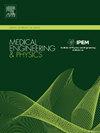Functional brain response pattern under rubber hand illusion based on fNIRS
IF 1.7
4区 医学
Q3 ENGINEERING, BIOMEDICAL
引用次数: 0
Abstract
The rubber hand illusion (RHI), where people experience a sense of ownership over a rubber hand, has been researched by various neuroimaging methods. Here we used functional near-infrared spectroscopy (fNIRS) to analyze the activation and functional connectivity of related brain regions under RHI. Meanwhile, three brain functional network parameters were calculated and analyzed: degree, clustering coefficient, and characteristic path length. fNIRS results showed that under RHI, the oxyhemoglobin (HbO) concentration increased in the prefrontal cortex (PFC), motor cortex (MC) and occipital lobe (OL). The functional connectivity between right PFC and bilateral OL was increased, while the connection level between left MC and bilateral OL was decreased. Brain network under RHI condition had smaller average degree, average clustering coefficient, and shorter average characteristic path length. Notably, the information processing and exchange functions of left MC seem to be weakened under RHI state, which was also partially corroborated by the reduced local efficiency shown in brain functional network analysis. Overall, we suggest that enhanced functional connectivity between the right MC, OL and PFC, and functional inhibition of the left MC were key to RHI production. The study significance lies in enhancing understanding of body ownership and sensory integration.

基于近红外光谱的橡胶手错觉脑功能反应模式
橡胶手错觉(RHI)是指人们对一只橡胶手有一种所有权的感觉,已经通过各种神经成像方法进行了研究。本研究利用功能近红外光谱(fNIRS)分析了RHI下脑相关区域的激活和功能连通性。同时,计算并分析了脑功能网络的三个参数:程度、聚类系数和特征路径长度。fNIRS结果显示,RHI作用下,大鼠前额皮质(PFC)、运动皮质(MC)和枕叶(OL)的血红蛋白(HbO)浓度升高。右侧PFC与双侧OL之间的功能连通性增加,而左侧MC与双侧OL之间的连接水平降低。RHI条件下脑网络的平均程度、平均聚类系数和平均特征路径长度较小。值得注意的是,在RHI状态下,左脑MC的信息处理和交换功能似乎被削弱了,这也部分印证了脑功能网络分析显示的局部效率降低。总的来说,我们认为右MC、OL和PFC之间的功能连接增强以及左MC的功能抑制是RHI产生的关键。本研究的意义在于增强对身体所有权和感觉统合的认识。
本文章由计算机程序翻译,如有差异,请以英文原文为准。
求助全文
约1分钟内获得全文
求助全文
来源期刊

Medical Engineering & Physics
工程技术-工程:生物医学
CiteScore
4.30
自引率
4.50%
发文量
172
审稿时长
3.0 months
期刊介绍:
Medical Engineering & Physics provides a forum for the publication of the latest developments in biomedical engineering, and reflects the essential multidisciplinary nature of the subject. The journal publishes in-depth critical reviews, scientific papers and technical notes. Our focus encompasses the application of the basic principles of physics and engineering to the development of medical devices and technology, with the ultimate aim of producing improvements in the quality of health care.Topics covered include biomechanics, biomaterials, mechanobiology, rehabilitation engineering, biomedical signal processing and medical device development. Medical Engineering & Physics aims to keep both engineers and clinicians abreast of the latest applications of technology to health care.
 求助内容:
求助内容: 应助结果提醒方式:
应助结果提醒方式:


